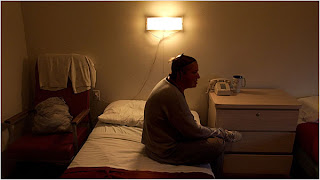skip to main |
skip to sidebar

From
The New York Times:
New York State discriminated against thousands of mentally ill people in New York City by leaving them in privately run adult homes, which effectively replaced state-run psychiatric hospitals more than a generation ago but turned out to be little more than institutions themselves, a federal judge ruled on Sept. 8.
The judge, Nicholas G. Garaufis of Federal District Court in Brooklyn, ruled that the state was violating the Americans With Disabilities Act by housing more than 4,300 mentally ill people in New York City in more than two dozen adult homes. He said the residents had little hope of mingling with anyone in the wider community.
The nonprofit group that sued the state had asked Judge Garaufis to tell state officials they could no longer steer mentally ill people into adult homes. He stopped short of that but directed the state to submit a “remedial plan” by mid-October.
The ruling, which applies to mentally ill people not considered dangerous to themselves or others, suggested that the state would have to begin finding individual apartments or small homes for virtually all adult-home residents who wanted one. A spokeswoman for Gov. David A. Paterson had no immediate comment about the 210-page decision. “We’re reviewing it,” said the spokeswoman, Marissa Shorenstein.
Judge Garaufis wrote that adult homes were “segregated settings” that kept residents from integrating their lives into the day-to-day rhythms and rituals of neighborhoods. He said the state had “denied thousands of individuals with mental illness in New York City the opportunity to receive services in the most integrated setting appropriate to their needs.”
He also wrote, “To the extent that mental health programs or case management aim to teach independent living skills, like cooking, budgeting and grocery shopping, residents have little or no opportunity to practice these skills in their present living situation.”
“We’re thrilled,” said Cliff Zucker, the executive director of Disability Advocates, the nonprofit legal services group that filed the case. “This is an extraordinarily important decision that is going to improve the lives of 4,300 people who are now being warehoused in institutions unnecessarily.”
Jeanette Zelhof, the deputy director of MFY Legal Services, one of a number of groups that helped with the legal work in the case, said the decision meant that adult-home residents “will no longer be stigmatized by living in adult homes.”
“In their communities,” Ms. Zelhof said, “these homes were seen as psychiatric institutions, and they were run like psychiatric institutions.” Disability Advocates had argued that many people in adult homes could be better served by living in their own apartments — in so-called supported housing, with mental health workers giving them the services they need when they need them — at no greater expense to the state.
The state had said that residents of adult homes — about 12,000 people statewide — already lived in an integrated setting. An additional 13,000 residents are in supported housing, and 4,000 to 5,000 are in psychiatric hospitals. The ruling applies only to New York City.
The adult-home system took shape in the 1960s and 1970s, when the state shut down a number of large state-run psychiatric hospitals as part of what became known as deinstitutionalization. State officials turned to profit-making adult homes because little had been done to prepare for housing the hospital patients after they were discharged.
Federal disability money was to pay for the homes and the meals and activities they would provide. The homes were responsible for bringing in psychiatrists and doctors.
In 2002, a series in The New York Times described conditions in adult homes based on a review of more than 5,000 pages of annual state inspection reports and 200 interviews with workers, residents and family members.
The investigation found that some adult homes were sprawling and chaotic. Some were havens for schemes to bring in Medicaid and Medicare money by all but forcing patients to undergo unneeded treatments from allergy shots to eye surgery.
The investigation also found that in some cases homes created sham records on residents that went undetected by state inspectors. The files had been generated at the last minute, in anticipation of the inspectors’ visits.
Judge Garaufis said the state had improved conditions at the adult homes since then, but the main contention of the lawsuit, filed in 2003, was that most of the residents did not belong there.
The judge’s decision came after a five-week trial in May and June. In the decision, he quoted at length from testimony by advocates for mentally ill people and by present and past officials from the state mental health system and other experts. Several adult-home residents also testified.
State officials said at the trial that adult homes permitted residents to come and go, that they were close to neighborhood amenities, and that supported housing was only for those who needed minimal assistance. But Judge Garaufis concluded that in some ways, adult homes “are even more restrictive or ‘institutional’ than psychiatric hospitals.”
“Living in a place where the phone is answered ‘Brooklyn Adult Care Center’ diminishes work options and social contacts,” the judge wrote, “and being subject to visiting hours diminishes opportunities to cultivate social or family relationships.”
Judge Garaufis also said that supported housing was less expensive than adult homes. He said the total cost for a mentally ill person in supported housing was $40,253 a year, compared with $47,946 for a resident in an adult home. A chart in the decision showed that the Medicaid cost for an adult-home resident was nearly double the cost for someone in supported housing.
The judge said the state’s cost analysis had failed to include millions in additional expenses for adult-home residents — expenses the state does not face for people in supported housing. Among the expenses were grants for air conditioning at nine adult homes.
 From The New York Times:
From The New York Times:
